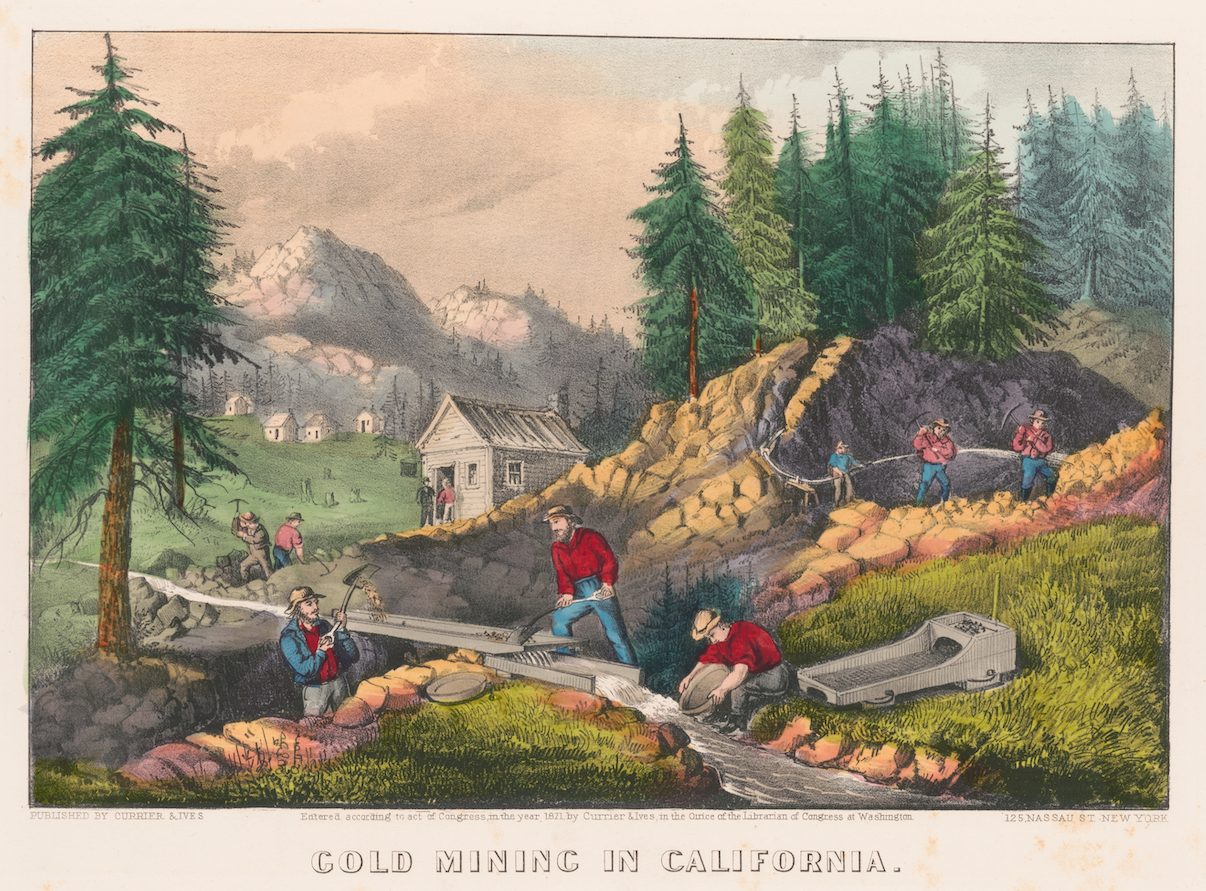Perhaps the most famous ingots are those from the early California gold rush which capture the essence of a bygone era. The Gold Rush started in January 1848 when John Marshall discovered a gleaming flake in the tail race of a sawmill at Sutter’s Fort near Sacramento. Soon, other flakes and nuggets were found, tests were made at Sutter’s Fort, and gold was positively identified. The news could not be contained, it soon reached San Francisco, and by late spring the Gold Rush was on! As the years passed, assayers, bankers, and other commercial interests were established in San Francisco, Sacramento and other towns, with gold remaining a focal point of interest. Miners, banks and others would receive gold then take it to an assayer who would melt it, cast it into bars or ingots, and then test it for its purity.
Very few California gold bars were known prior to the recovery of gold from the ‘Ship of Gold’ known as the SSCA shipwreck. The most famous and most prolific of those was from Moffat & Co.
1. Moffat & Co
Among the earliest and most successful private gold assayers and smelters during the California Gold Rush was Moffat & Company, headed by John Little Moffat of New York State. Moffat had previously worked in the gold fields of North Carolina and Georgia, and he came to California well-prepared to serve the miners who needed to have their gold dust weighed, evaluated, and converted into bars or ingots.
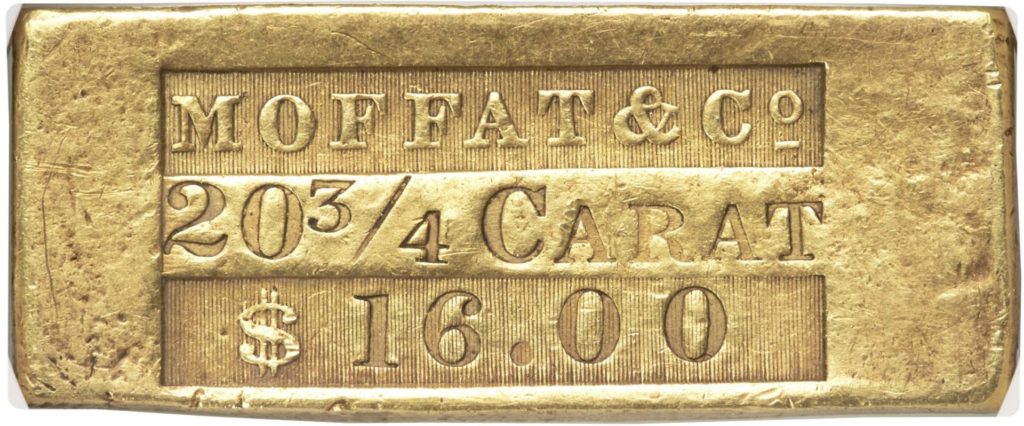

The small rectangular gold ingots that Moffat & Company produced, including the present piece, must have been made shortly after the opening of their business. By late August, the company was engaged in the minting of gold coins, after procuring the services of George Albrecht Ferdinand Kuner, recently arrived from New York, as their chief engraver. Apparently produced in denominations ranging from $9.43 to $264, few of the ingots still exist. Probably only 15 to 20 of the $16.00 ingots survive.
See: https://rareingot.com/moffat-co-assayers/
2. F. D. Kohler
Frederick D. Kohler, a jeweler and volunteer fire fighter from New York City, moved to California in 1849 and started a private assayer firm with David C. Broderick. When the State Assay Office was created, Governor Burnett appointed Kohler as California’s first and only State Assayer on April 20, 1850.
The State Assay Office at San Francisco was opened on May 13th, 1850 by Frederick Kohler. His ingots proved to be very useful to miners and merchants but many bankers refused to redeem them at full value which created quite a problem.
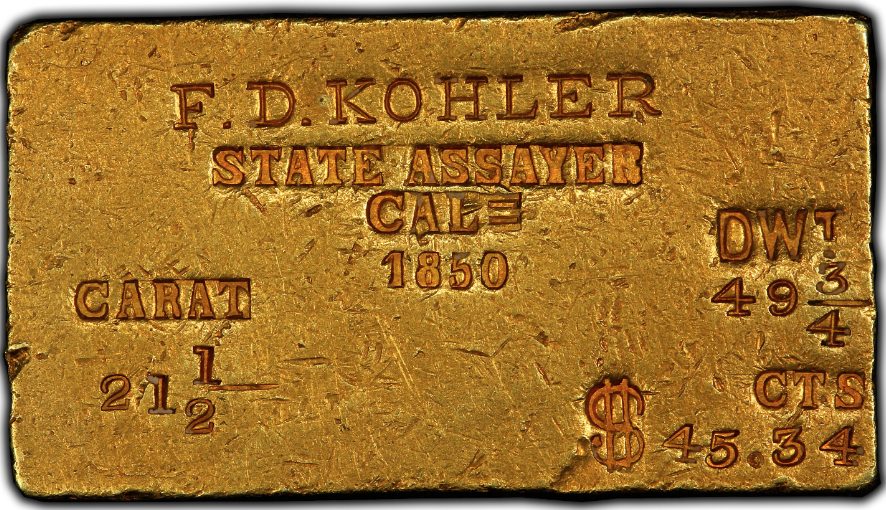
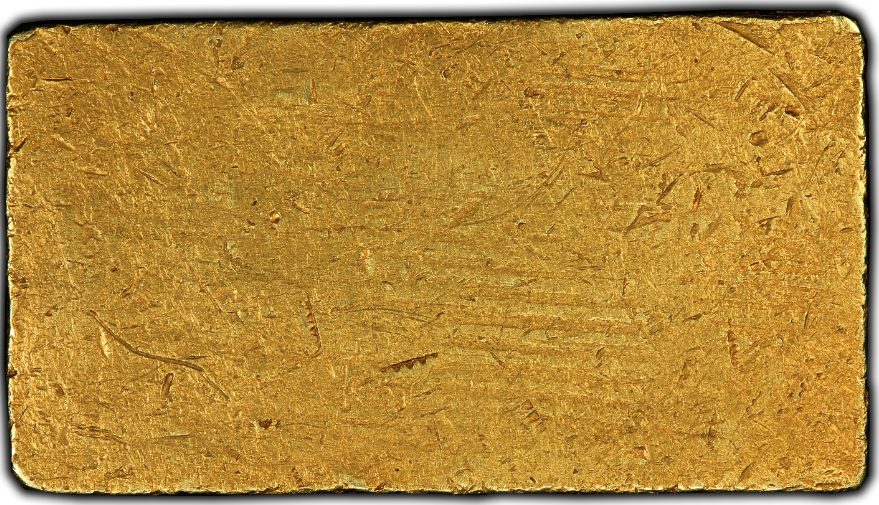
Only 4 ingots have been seen in recent history. PCGS has identified approximately 7 in their spec database.
See: https://rareingot.com/f-d-kohler-assayer/
3. J. Reed
Not much is or was known about J Reed, other than that he may have been a San Francisco assayer active around the centennial in 1876. The piece is clearly of a commemorative nature and may have been a commercial product made for sale in San Francisco in the expectation of profiting from the national festivities as well as the growing self-consciousness of the 49’er generation.

Assuming the “3 OUNCES” on the bar are Troy ounces, then 3 Troy ounces of .883 fine gold are equivalent to 2.649 ozst. of 1.0 fine gold. This is the only surviving ingot from this assayer and last traded in 2007 at the famous Ford auction held by Stacks Bowers.

See: https://rareingot.com/j-reed-assayer/
4. Kellogg & Hewston
John Grover Kellogg was a private assayer that went through several stages of business and historic partnerships, the last of which was his partnership with Hewston that lasted through 1866.
Many of Kellogg & Humbert bars were discovered on the SS Central America shipwreck as a testament to the scope of their operation and trust the community had in their work. In fact, of all the ingots discovered on the shipwreck Kellogg & Humbert’s outnumbered them all. Augustus Humbert was the Assayer for the US Treasury in 1850.
Only TWO ingots survive from Kellogg & Hewston – one is predominantly silver (mixed metal gold and silver), and the other is predominantly gold.


This splendid and highly prized piece was in the Waldo Newcomer Collection, the famed repository of Pioneer Gold coins. Originally unknown to Edgar Adams when he published his book in 1913, the piece made its debut in a 1929 Auction Sale conducted by Thomas L. Elder, the late renowned numismatist and dealer.
See: https://rareingot.com/kellogg-hewston-assayers/
5. Thomas Price
Thomas Price was one of the most educated assayers on the western frontier. Early on, price went to work as an assayer with Kellogg, Hewston & Co. Thomas Price ingots are very rare. There are perhaps less than five silver and one gold ingot known. They date to the 1875-1885 period when Price was on his own before his son was added as a partner.
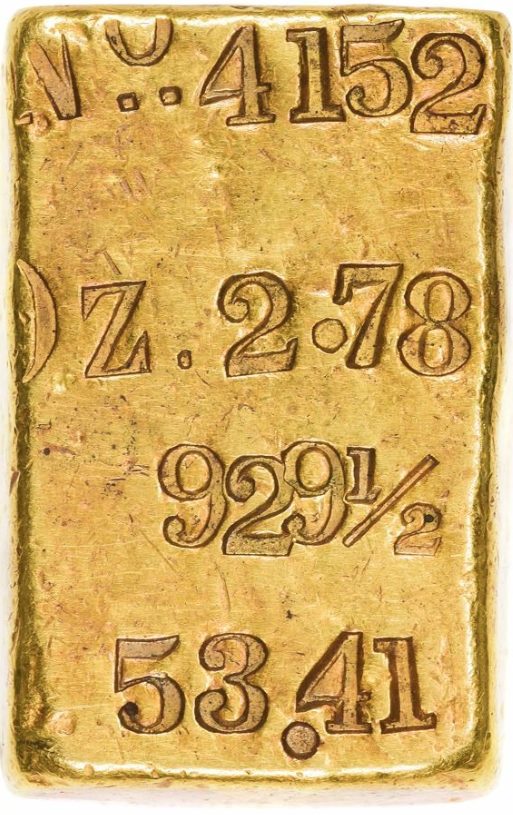
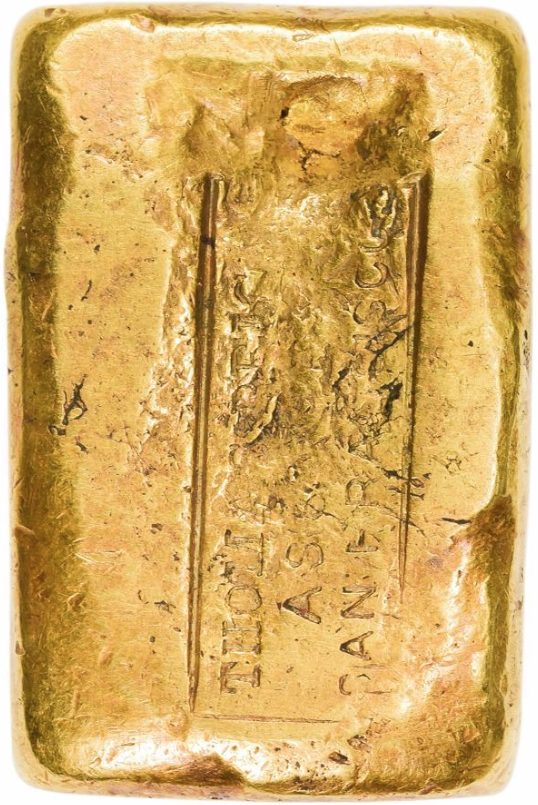
This piece is absolutely exceptional as it is the ONLY surviving gold ingot known. Gold pieces from the 19th century are rare in their own right, and it is a special treat when you get to encounter a one-of-a-kind piece such as this one made by an important Assayer of the time.
Undoubtedly a functional ingot, this piece was likely used as actual currency given its present condition and wear. This piece stands atop all the other Thomas Price ingots as the only one made primarily out of gold at a stated purity level of 929.5 fine!
See: https://rareingot.com/thomas-price-assayer/
6. Meyers & Co
As the ONLY Unique Monetary Ingot or Coin of the California Gold Rush, the Meyers & Co $18 ingot stands atop all ingots as the grandaddy of them all.
While most coins and ingots of the early California Gold Rush are undeniably rare, Meyers & Company is the ONLY firm that produced Pioneer Gold that is known by only one gold coin or bar. As such, the importance of this historic piece cannot be underestimated.
David McCarthy (Kagin’s)


Overall appearance of Extremely Fine. Nice, bright yellow gold color. Top and bottom corners on left trimmed when made creating a rectangular ingot with six sides. Minor roughness, particularly on the back. Edge test cut. Unique.
See: https://rareingot.com/meyers-co-assayers/
7. G. W. Bell
The Assay Office of G.W. Bell, established in 1859, was located in Parrott’s Iron Building on California Street, one door west of Montgomery, in San Francisco. Trade directory advertisements noted that “Gold Dust, Ores & Minerals of Every Description Assayed. Returns Made at the Usual Rate of Commission with Correctness and Dispatch.
Three gold ingots are known and the origins are uncertain possibly with ties to Ford, although at least one of them bears a distinct undertype that may not be of the same origin which warrants further research.
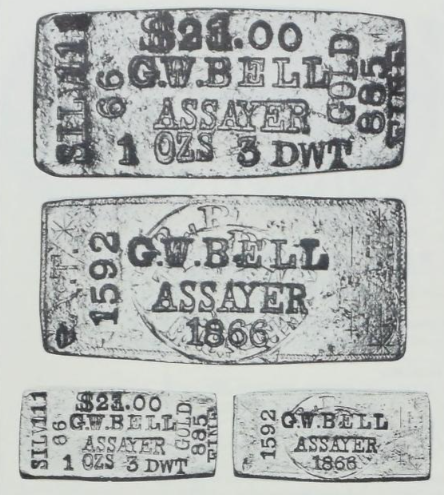
The only dated Bell ingot and the only one with an IRS (OIR) stamp, and the only one dated (1866). This bar contains more elaborate inscriptions than the preceding and is dated 1866, the year of Bell’s death. It probably was among his last productions.
Further examination reveals a lightly engraved inscription on the back, possibly indicating that the piece was given as a gift at one time. This inscription seems to read “A.T. to HAT.” Does A.T. refer to a name or Arizona Territory?
See: https://rareingot.com/g-w-bell-assayer/
8. SSCA Shipwreck Assayers
Several assayers were well known during the California gold rush days, and 5 of them represent the ingots recovered on the SSCA. Until the recovery of the S.S. Central America buried treasure, very few assayer bars remain from the mid 1800’s.
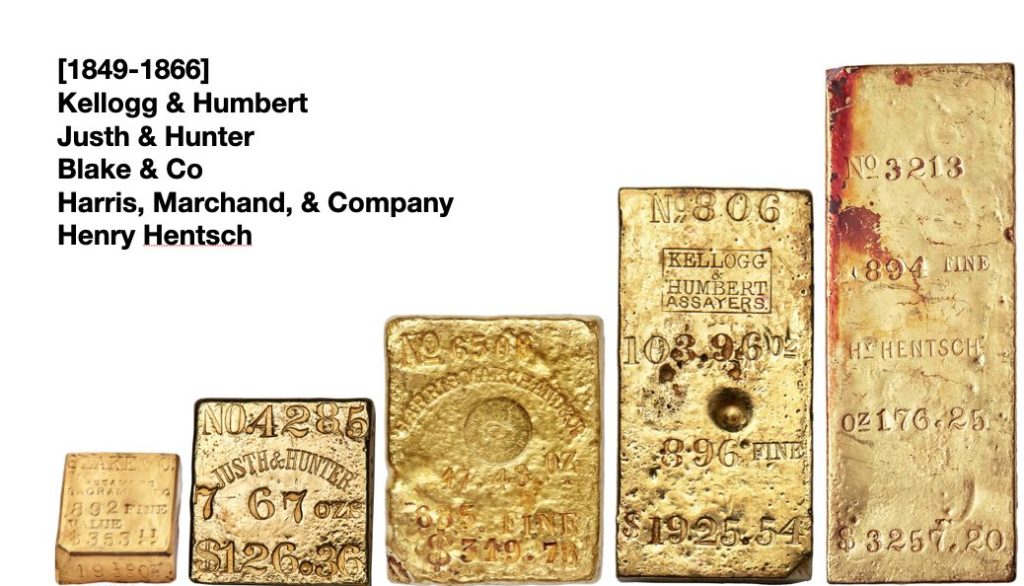
For more information on each of the Assayers, you may visit the links below:
- Kellogg & Humbert: https://rareingot.com/kellogg-humbert/
- Justh & Hunter: https://rareingot.com/justh-hunter-assayers
- Blake & Co: https://rareingot.com/blake-co-ssca
- Harris, Marchand & Co: https://rareingot.com/harris-marchand-co
- Henry Hentsch: https://rareingot.com/henry-hentsch
Bonus: John J. Ford Jr. (Fantasy)
It is difficult to collect ingots and not occasionally come across the name of John J. Ford Jr. in some fashion. Although we will not dive into the history surrounding his backstory here, suffice it to say that quite a few ingots that passed through his hands were not genuine despite purporting to be real at the time. This created quite a bit of confusion in the industry and made it difficult for some at the time to easily distinguish real from fake — fact from fiction — genuine from fantasy. Many of those ingots purported to be from California.

Furthermore, many of those fantasy ingots are housed at the Smithsonian Institution after being donated by the Josiah Lily collection who acquired them with the belief they were all genuine at the time. For a list of various fantasy ingots, many of which are “California Gold” (emphasis on the air quotes!), see: https://rareingot.com/category/fantasy/.
For a summary of the Ford Gold bars that are theoretically possible to collect in private hands, see: https://rareingot.com/collecting-ford-gold/.

